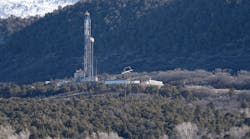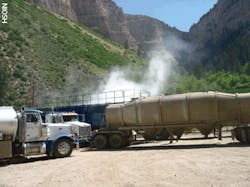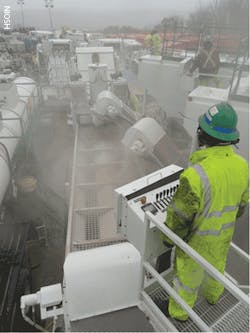Fracking. The word alone can stir up controversy. The process of extracting natural gas through hydraulic fracturing, or "fracking," might summon in your imagination a ravaged environment and damaged communities. Or perhaps you envision a prettier picture – one that involves clean-burning fuel, job growth and affordable energy.
Either way, fracking is no different from any other operation in the oil and gas industry in that it presents its own set of occupational hazards and requires appropriate use of engineering controls, industrial hygiene monitoring and personal protective equipment to ensure workers are not sickened, injured or killed on the job.
Subscribe to EHS Today Magazine to receive leading coverage of the EHS industry.
The National Institute for Occupational Safety and Health (NIOSH) states that fracking "is the process of injecting large volumes of water, sand, and chemicals into the ground at high pressure to break up shale formation allowing more efficient recovery of oil and gas." This practice has grown rapidly over the course of the last decade thanks to improved technologies, but it also has fostered debates concerning its environmental, health and safety impact along the way.
A Divisive Practice
Environmental advocates argue fracking contributes to air and water pollution and could have dire health and environmental consequences for nearby communities. Some studies support these claims, including recent research from Cornell University that uncovered dying livestock near fracking sites, which some say could suggest implications for human health.
Industry, meanwhile, stresses that safety is important.
"The oil and natural gas industry's number one priority is safety," says Carlton Carroll, American Petroleum Institute (API) spokesman. "We are proud of our strong safety record but even one incident is too many, so we update our standards and best practices on an ongoing basis to improve our record and protect our employees and our environment."
The industry also points to the benefits of fracking. In a December 2012 press release, API called the extraction of natural gas from shale "the most important domestic energy development in the last fifty years ... poised to reshape American manufacturing." And Chevron's Web site touts the practice for "providing the United States with reliable, affordable, cleaner and responsibly produced energy. Developing these natural gas resources can help enhance the country's energy security, strengthen local and state economies, and fuel job growth."
Robert Emery, DrPH, a chemical safety expert with the University of Texas (UT) Health Science Center at Houston and a professor at the UT School of Public Health, suggests the oil and gas industry would be well served to take a proactive approach when addressing worker safety concerns in hydraulic fracturing.
"Given the sensitivities environmentally, whether real or perceived, that are associated with fracking, it behooves the industry to maintain both health and safety programs for their employees and the communities they're interacting with," Emery explains.
But some experts argue that workers within the industry are not adequately protected from the dangers they may face. The most significant and emerging occupational health and safety concern in the fracking industry at this time, according to NIOSH research, is exposure to high levels of crystalline silica.
Crystalline Silica Exposure
Recent research from NIOSH focused on silica exposure for workers in fracking. The sand used in hydraulic fracturing contains up to 99 percent silica. Workers who inhale silica dust may be at risk of developing silicosis, an incurable lung disease, and lung cancer. Silica exposure also has been linked to tuberculosis, chronic obstructive pulmonary disease, and kidney and autoimmune disease.
According to the NIOSH Science Blog "Worker Exposure to Crystalline Silica During Hydraulic Fracturing," the high percentage of silica in the sand used in fracking means the dusts formed during handling may contain more respirable crystalline silica than other silica-generating industries, and employers "who do not control dust put their workers at risk and may not be in compliance with regulations."
NIOSH conducted field investigations of 11 fracking sites and discovered silica exposures that far exceeded recommended or permissible limits. Of the 116 full-shift air samples NIOSH tested at hydraulic fracturing sites in Arkansas, Colorado, North Dakota, Pennsylvania and Texas, 31 percent had silica exposures that exceeded NIOSH's recommended exposure limit by 10 times or more. Nearly half (47 percent) of the samples exceeded OSHA's permissible exposure limit (PEL) for silica, and 9 percent had silica exposures that exceeded OSHA's PEL by 10 times or more.
"Hazardous respirable silica exposures to some workers that may occur during hydraulic fracturing is an industry-wide problem and not confined to just one or a few companies," says Eric Esswein, senior industrial hygienist at NIOSH. "The hazard arises from the huge volume of silica-containing sand used as proppant and the transfer and handling of that sand creates respirable dust that can present an occupational hazard."
The field investigation results led NIOSH to conclude "that an inhalation health hazard existed for workers exposed to crystalline silica at the evaluated hydraulic fracturing sites ... We recommend that all hydraulic fracturing sites evaluate their operations to determine the potential for worker exposure to crystalline silica and implement controls as necessary to protect workers."
NIOSH stressed that personal respiratory protection alone is not sufficient to protect workers from these levels of silica exposure. To protect workers from silica exposure in fracking operations, NIOSH recommends:
- Use a less hazardous non-silica proppant (e.g., ceramic) where feasible.
- Use local exhaust ventilation for capture and collection.
- Use passive enclosures at points of dust generation.
- Minimize distances between the dragon tail and T-belts and blender hoppers.
- Replace transfer belts with screw augers on sand movers.
- Use amended water (e.g., containing chloride and magnesium salts) to reduce dust generation on roads into and at the well site.
- Mandate use of cam-lock caps for fill ports on sand movers.
- Use administrative controls.
- Provide worker training.
- Monitor workers to determine their exposure to crystalline silica.
- Use appropriate respiratory protection as an interim measure until engineering controls are implemented.
To read about these recommendations in full, visit http://blogs.cdc.gov
/niosh-science-blog/2012/05/silica-fracking/ or access the OSHA and NIOSH's joint Hazard Alert, "Worker Exposure to Silica during Hydraulic Fracturing," on OSHA's Web site.
Addressing Fracking Hazards
"I applaud NIOSH for putting out this sort of [hazard] alert," Emery said. "When you detect samples in excess of regulatory limits, we need to find a quick way to get [this information] out to industry. If we wait for rulemaking, that can take quite a long time. I also applaud their efforts to get out recommended ways to protect from and avoid exposures. To me, it's an indication of the system working."
While Esswein asserts that NIOSH's initial hazard assessments identified silica exposure as "the most significant health hazard to workers" in fracking, other potential hazards may include exposure to benzene and diesel particulate matter. According to the OSHA-NIOSH Hazard Alert, additional hazards in fracking include being struck by moving equipment, tools and falling objects; motor vehicle accidents; poor lighting; being caught in pinch points; falling from heights; fire or explosions; working in confined spaces; and more.
NIOSH has created an internal, multi-disciplinary team of researchers to identify and examine additional safety and health hazards within this industry. Additionally, the National Service, Transmission, Exploration & Production Safety (STEPS) Network formed a Respirable Silica Focus Group in June 2012, of which NIOSH and OSHA are members.
"There Are No Walls"
Miriam Rotkin-Ellman, MPH, a National Resources Defense Council (NRDC) public health scientist, calls the silica exposure "a huge worker safety concern, one that should have never happened if this industry wasn't cutting health and safety corners."
Unlike other industries, she says, the risks posed to workers in hydraulic fracturing often are the same risks that face the surrounding population.
"The line between the community and the workplace is really pretty thin or in many places nonexistent," Rotkin-Ellman says of fracking. "These are not buildings that house workers inside them. The drill sites are in communities and up against people's homes; there are no walls. The truck traffic that endangers workers also endangers communities. What we see on the occupational side raises concerns for the community side and vice versa."
More than 100 medical experts publicly agree that fracking possibly could pose harm to the health of surrounding communities and that additional research is needed to ensure the environment and human health is protected. A petition facilitated by Physicians, Scientists & Engineers for Healthy Energy (PSE) and sent to the White House Dec. 13, 2012, garnered 107 signatures of concerned U.S. medical professionals, researchers and other scientists. These experts signed the petition to discourage the Obama administration from fast-tracking the permitting process for new liquefied natural gas export terminals.
"There is a growing body of evidence that unconventional natural gas extraction from shale (also known as ‘fracking') may be associated with adverse health risks through exposure to polluted air, water, and soil," the petition reads. "Public health researchers and medical professionals question the continuation of current levels of fracking without a full scientific understanding of the health implications ... We assert that a guiding ethical principle for public policy on fracking should parallel that used by physicians: ‘First, do not harm.'"
Rotkin-Ellman adds that while the rapid growth of the fracking industry might be a fairly recent development, there's a lot about the industry that isn't new, and there are no excuses for not protecting workers.
"This industry should have been paying attention and not letting people work in dangerous situations," she says. "Silica is a longtime known hazard. There's no reason for the unsafe levels of exposure that were discovered by NIOSH scientists. The types of controls that are required – dust control, proper equipment and PPE – are well-known occupational [solutions], but this industry just didn't do [enough] to to protect workers. The technology is available, the science is there, and we know the best way to do this, but it's not being done."


